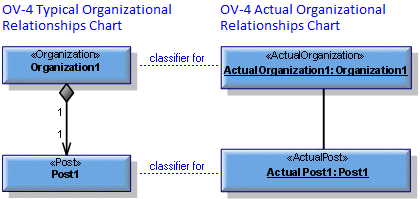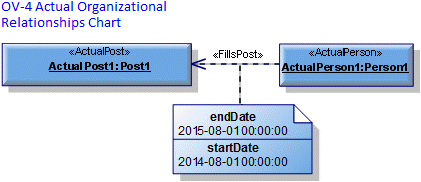OV-4 Post fulfillment table (UPDM - MODAF aliases)

Creation
To create an OV-4 Post Fulfillment Table:
• Right-click the
Architectural Description or
Service Description that is to own the OV-4 Post Fulfillment Table, point to New, point to Matrix/Table, point to MODAF, and then click OV-4 Post Fulfillment Table.
When you open an OV-4 Post Fulfillment Table, Modeler can generate it as HTML for viewing in your Internet browser, or generate it as a spreadsheet for viewing in Microsoft Excel. To specify how matrices and tables are opened for a model: in the Packages pane, right-click the Model, point to > > , and then select HyperTextMarkupLanguage_HTML or Excel_XLS.
Each time you open an OV-4 Post Fulfillment Table, Modeler generates the product using the latest data from the model.
Purpose
On an OV-4 Post Fulfillment Table:
Elements Shown

The OV-4 Post Fulfillment Table shows the following elements:
• A row is created for each
Actual Organization element that is found in the analyzed Packages.
• For each Actual Organization row, a sub-row is created for each
Actual Post element that is linked to the Actual Organization element.
An Actual Post can be linked to an Actual Organization through an
OV-4 Actual Organizational Relationships Chart, but only when the Actual Post element's classifying Post is linked to the Actual Organization element's classifying Organization through a composite Association. This composite Association can be created on an OV-4 Typical Organizational Relationships Chart.
• For each Actual Post sub-row, a further sub-row is created for each
Actual Person element that is linked to the Actual Post element through a
Fills Post relationship.
The Start Date and End Date of the Fills Post relationship determines the date range that is shown on the table through blue shaded cells.
Analyzed Packages
By default, the OV-4 Post Fulfillment Table searches for Actual Organization elements that are contained within the Architectural Description or Service Description that owns the OV-4 Post Fulfillment Table.
To search for Actual Organization elements from other Architectural Description and Service Description packages:
Right-click the OV-4 Post Fulfillment Table, point to Links, and then click Analyzed Packages. From the Links Editor, select the Architectural Description and Service Description packages from which you want to search for Actual Organization elements.
Example
In this example, the Architectural Description that owns OV-4 Post Fulfillment Table1 contains Actual Organization1.
On an OV-4 Actual Organizational Relationships Chart, we link Actual Organization1 to Actual Person1. We can create this link because their classifiers (Organization1 and Post1) are linked through a composite Association on an OV-4 Actual Organizational Relationships Chart.

On the OV-4 Actual Organizational Relationships Chart, we link Actual Person1 to Post1 using a Fills Post relationship. We set the start date of the Fills Post relationship to 2014-08-01 and the end date of the Fills Post relationship to 2015-08-01.

We now generate OV-4 Post Fulfillment Table1, and a row is created for Actual Organization1 because it is found in the analyzed Packages.
 from the table you can see the following:
from the table you can see the following:• Actual Post1 is linked to Actual Organization1.
• Actual Post1 is filled by Actual Person1 from 2014-08-01 to 2015-08-01.
The following sections provide information about how an OV-4 Post Fulfillment Table is used in the model.
Create an OV-4 Post Fulfillment Table from
Creates or shows these UPDM elements





